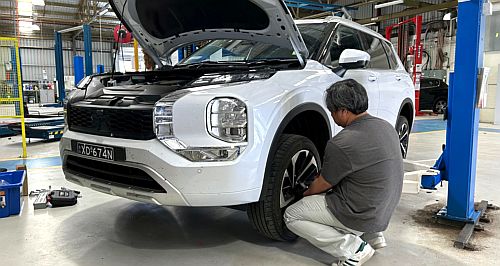Make / Model Search
News - MitsubishiMitsubishi revives Australian chassis tuningJapan HQ reawakens MMAL’s local tuning efforts led by Tony Dorrington10 Jul 2025 By TOM BAKER THE STORY of Australia’s contemporary car industry is one characterised by local experts deftly re-engineering and re-tuning vehicles manufactured elsewhere. We might not make cars Down Under—but talented in-house chassis tuning teams tend to improve them.
The latter effect lent considerable legitimacy to Hyundai and Kia vehicles locally, transforming their dynamic reputation from ‘iffy’ to ‘sophisticated’ in under two decades. Now, it’s Japan’s Mitsubishi Motors Corporation (MMC) looking to lean into incremental chassis improvement identified by Australian tuning.
Following a soft launch ahead of the local release of the ‘MC’ Triton ute in 2024, MMC has officially requested local arm Mitsubishi Motors Australia Limited (MMAL) to reawaken its long-dormant local ride and handling tuning program led by veteran engineer Tony Dorrington.
Leaning against a locally-tuned MY25 Outlander on a chilly South Australian day, Mr Dorrington spoke with GoAuto on at the sidelines of the Yankalilla football ground—its sextet of goalposts marking the start/finish of a punishing 26-kilometre road loop punctuated by off-putting camber and surface changes.
Mr Dorrington has re-assembled a small team, complemented by a second-in-command from Japan, to complete suspension and steering tuning tasks assigned by head office relating to current and future vehicles. Adjustments to the new Triton and facelifted MY25 Outlander were the first official jobs.
MMAL’s return to local chassis tuning will see Mr Dorrington’s program inevitably compared to other well-known efforts including Graeme Gambold’s operation at Kia Australia, while Chinese marque GWM recently made a big-name hire in revered ex-Holden engineer Rob Trubiani to lead Australian adjustment efforts.
The reconstituted MMAL chassis team is splitting time between a high-tech workshop within Mitsubishi Australia’s Adelaide office; a challenging South Australian country road loop representative of classic Aussie B-roads; and the former General Motors/Holden proving ground at Lang Lang, Victoria.
It’s an agile operation targeted at isolating issues within ‘work streams’ allocated by MMC in Japan—such as improving bump/rebound damping for the Outlander—and identifying in-budget solutions for those issues without resorting to major engineering changes at the factory level.
Within MMC, while the Tokyo-based head office has final say over any project, significant delegation is given to ‘recognised R&D centres’ of which there are three in Japan (Aichi, Kyoto and Hokkaido), plus two in the US (Michigan and California), and a European R&D base in Hessen, Germany.
MMAL’s Adelaide-based operation remains a long way from becoming a recognised R&D centre but Mr Dorrington shared with GoAuto that such certification is the goal.
“I’m hoping (MMC) gives us full R&D accountability,” Mr Dorrington said. “Being a recognised R&D centre would allow us to do our own work in isolation rather than exclusively contributing to (existing) MMC work streams.”
Becoming a recognised R&D centre would be a major upgrade in every way—team size, budget, facilities and seniority within MMC.
Australia has only a few vehicle proving grounds; Lang Lang, owned by Vinfast and offered for sale at various times in the last five years, is one. Ford operates the You Yangs, Victoria proving ground, with the state also home to the Linfox-owned Australian Automotive Research Centre at Anglesea.
“Lang Lang and I go way back to when I was working for Bridgestone (1997-2003) and was based there doing tyre development with Holden,” Mr Dorrington said. “As well as the ride and handling circuit, the hill route is invaluable (to MMAL), as is the truck road.”
Mr Dorrington would not be drawn on the notion that MMC ought to purchase Lang Lang, but offered us a chuckle.
After Bridgestone, Mr Dorrington was employed by MMAL in January 2003 as a vehicle proving engineer, rising to manager of vehicle proving (2004-2005) while the Australian-made Mitsubishi 380 was still in production.
The 380 large sedan, and its Magna predecessor, were the final vehicles to undergo chassis development and tuning by MMAL. Notably, Mitsubishis of the recent past with mediocre handling, such as the outgoing first-gen ASX, were never tuned or adjusted in Australia.
While there are clear constraints on the MMAL chassis team in the current environment, Mr Dorrington was reasonably free to adjust the parameters of existing Outlander suspension and steering hardware, and even a few physical parts were replaced in the MY25 facelift changeover.
Alterations to the Outlander include effective replacement of the rear shock absorbers. While the KYB damper is retained the piston is almost completely different while the bump and rebound strokes have been altered and spring rates are new.
A changeover to pricier and grippier Bridgestone Alenza SUV tyres for 20-inch wheel-equipped Outlanders was secured while a full remap of the electronic power steering system was completed by the Australian team.
The Australian team has not yet been asked to evaluate or adjust other dynamic characteristics such as electronic stability control or throttle/CVT mapping, though such work is a possibility for the future.
MMC regards the Outlander retune as a success, which will not only be a feature of the Australian-market version—instead, MMC has adopted ‘our’ Outlander tune for all global customers in a champagne moment for Mr Dorrington’s efforts.
Despite the sensitivity of its launch in Australia, the incoming second-generation ASX—a rebadged Renault Captur developed in France—will not be retuned by MMAL on Australian roads, but British and European media reports suggest its ride and handling characteristics are sophisticated.
Next on the list for MMAL’s local tuning is a vehicle that might not be as well-prepared as a European-engineered Renault out of the box: Mitsubishi’s first dedicated mass-produced BEV for Australia, a 4320mm-long small SUV built by Taiwanese smartphone component manufacturer Foxconn.
Hardcore suspension and steering work is currently being finalised for the Foxconn-built BEV, with the Taiwanese firm dispatching its own chassis team to South Australia to work alongside Mr Dorrington’s squad.
“We have been working on the Foxconn car,” Mr Dorrington said. “We have been driving the competitive set at Lang Lang and spending a week getting a sense of Australian road conditions and the market in as many places as possible. We will be involved with (prototype) tuning.”
Involvement with the Foxconn vehicle will give MMAL’s chassis team important exposure to a vehicle that needs to be imbued with recognisable Mitsubishi traits—and MMC will undoubtedly be watching.
Outside the Foxconn BEV, the efforts will continue to involve fine-tuning more familiar Mitsubishi product, with large and small adjustment jobs.
“As someone that’s worked for a Japanese company for almost all of my working career, we have a philosophy of continuous improvement” Mr Dorrington said.
 Read more |
Click to shareMitsubishi articlesResearch Mitsubishi Motor industry news |












Facebook Twitter Instagram